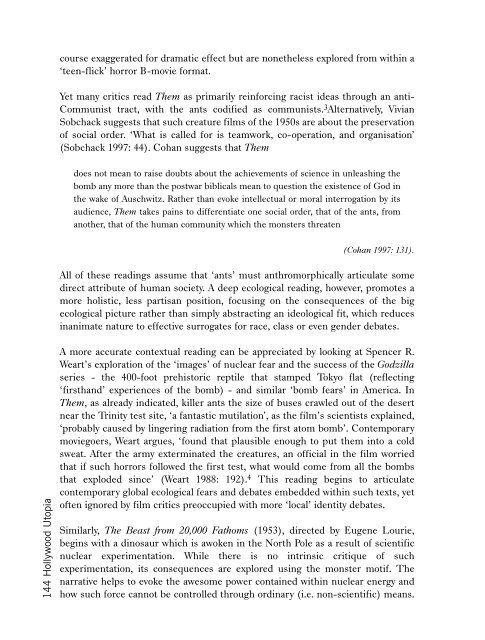Hollywood Utopia
Hollywood Utopia
Hollywood Utopia
You also want an ePaper? Increase the reach of your titles
YUMPU automatically turns print PDFs into web optimized ePapers that Google loves.
144 <strong>Hollywood</strong> <strong>Utopia</strong><br />
course exaggerated for dramatic effect but are nonetheless explored from within a<br />
‘teen-flick’ horror B-movie format.<br />
Yet many critics read Them as primarily reinforcing racist ideas through an anti-<br />
Communist tract, with the ants codified as communists. 3 Alternatively, Vivian<br />
Sobchack suggests that such creature films of the 1950s are about the preservation<br />
of social order. ‘What is called for is teamwork, co-operation, and organisation’<br />
(Sobchack 1997: 44). Cohan suggests that Them<br />
does not mean to raise doubts about the achievements of science in unleashing the<br />
bomb any more than the postwar biblicals mean to question the existence of God in<br />
the wake of Auschwitz. Rather than evoke intellectual or moral interrogation by its<br />
audience, Them takes pains to differentiate one social order, that of the ants, from<br />
another, that of the human community which the monsters threaten<br />
(Cohan 1997: 131).<br />
All of these readings assume that ‘ants’ must anthromorphically articulate some<br />
direct attribute of human society. A deep ecological reading, however, promotes a<br />
more holistic, less partisan position, focusing on the consequences of the big<br />
ecological picture rather than simply abstracting an ideological fit, which reduces<br />
inanimate nature to effective surrogates for race, class or even gender debates.<br />
A more accurate contextual reading can be appreciated by looking at Spencer R.<br />
Weart’s exploration of the ‘images’ of nuclear fear and the success of the Godzilla<br />
series - the 400-foot prehistoric reptile that stamped Tokyo flat (reflecting<br />
‘firsthand’ experiences of the bomb) - and similar ‘bomb fears’ in America. In<br />
Them, as already indicated, killer ants the size of buses crawled out of the desert<br />
near the Trinity test site, ‘a fantastic mutilation’, as the film’s scientists explained,<br />
‘probably caused by lingering radiation from the first atom bomb’. Contemporary<br />
moviegoers, Weart argues, ‘found that plausible enough to put them into a cold<br />
sweat. After the army exterminated the creatures, an official in the film worried<br />
that if such horrors followed the first test, what would come from all the bombs<br />
that exploded since’ (Weart 1988: 192). 4 This reading begins to articulate<br />
contemporary global ecological fears and debates embedded within such texts, yet<br />
often ignored by film critics preoccupied with more ‘local’ identity debates.<br />
Similarly, The Beast from 20,000 Fathoms (1953), directed by Eugene Lourie,<br />
begins with a dinosaur which is awoken in the North Pole as a result of scientific<br />
nuclear experimentation. While there is no intrinsic critique of such<br />
experimentation, its consequences are explored using the monster motif. The<br />
narrative helps to evoke the awesome power contained within nuclear energy and<br />
how such force cannot be controlled through ordinary (i.e. non-scientific) means.
















